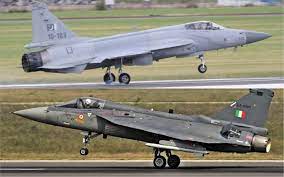It was an amazing experience to watch the Indian Air Force(IAF) Tejas flying at the Dubai Air show a few days last month. I was amazed to watch an Indian pilot of Tejas, flying this “machine” very carefully without any maneuverability, which was clearly reflecting limitations and flaws in its basic design.
Although Indians were proudly presenting their Tejas fighter jet, they forgot that even after its design finalization in the 1990s, India was still not able to induct this aircraft into its own air force. Tejas is the first warplane in the world whose 38 prototypes produced are rejected and not inducted into IAF. But ironically Hindustan Aeronautics Limited (HAL) is now working on Tejas MK-1/MK-1A to induct into IAF in 2023-2024. On the other hand PAF didn’t only produce and induct the JF-17 fighter jet, but also successfully used them against Indian attack on 27 February 2019.
Hindustan Aeronautics Limited (HAL) was successful in developing HAL HF-24 Marut fighter-bomber aircraft, designed by a German engineer hired by HAL in 1950s. IAF MiG-2 variants, had been the mainstay of the IAF since 1963 and it didn’t only celebrate and praise their most precious fighter jet but were gratified by overhauling and manufacturing facilities provided by Russians, since 1964. Russia, the UK and France, delivered advanced fighter jets and their generous technological help enabled India to develop advanced and modern facilities at HAL during the 1960s and 1980s. Many world renewed companies such as Mikoyan-Gurevich, Airbus, Boeing, Dassault-Breguet Aviation and Honeywell begin working with HAL to manufacture aircraft spare parts, but Indians fail to establish their own independent aircraft building and manufacturing industry from these facilities.
In 1983, the Government of India established the Light Combat Aircraft project (Tejas) with the initial goal to develop a new light combat aircraft to replace the ageing IAF fighters, especially the MiG-21 variants, which had been the mainstay of the IAF since 1963. IAF also struggled to replace the huge fleet of MIG-23s, MIG-25s and MIG-27s which were almost grounded in the early and late 1990s. Due to delays in the Tejas project IAF decided to procure Su-30MK-1 and signed a contract with Russia. IAF inducted a total 272 Su-30MK-1 from 1996 to 2020 under license production at Hindustan Aeronautics Limited (HAL).
The Tejas first prototype flew its first flight in 2003 exactly 20 years after the programme was initiated in 1983, but due to many technical shortcomings and flaws IAF rejected this aircraft in 2005. In-fact this project basic design was developed by Dassault-Breguet Aviation France which was based on a Mirage delta wing configuration based on Mirage-5 and due to delays, and the technology of this system became outdated before it ever become part of IAF.
After many years of evaluation and testing of Tejas it proved to be an ultimate failure and the IAF lost all its aircrafts due to the terrible quality standard of HAL. According to reports IAF lost more than triple aircrafts in accidents than in all wars combined that were fought since independence. Although HAL blamed IAF for the low standard of pilot training and IAF blamed HAL for low service standard, in this situation IAF procured the Dassault Rafale from France and initiated upgrading of its Mirage-2000s, MIG-29s and SEPECAT Jaguars.
In May 2015, Government of India allowed HAL to upgrade Tejas to the standard of MK-1, by improving more than 40 shortcomings. Later on HAL announced its final version as Tejas MK-1A to be delivered by 2024.
PAF with less than half of IAF strength, crossed many milestones in a shorter period of time as Pakistan Aeronautical Complex (PAC) started operating in 1971, and were able to rollout and locally rebuild F-6 (MIG-19) and Mirages in 1980s. Pakistan successfully co-produced K-8 with China in 1994 with 40 percent of parts manufacturing locally. Pakistan very successfully upgraded F-6, A-5 , F-7 and Mirage aircraft locally. PAF F-16 fighter jets, C-130 transport aircraft and Cobra Helicopters remained operational even during US embargos.
In June 1999, Pakistan and China signed the contract to jointly develop and produce the Chengdu FC-1/Super 7. Prototype production began in September 2002; a full-size mock-up of the FC-1/Super 7 was displayed at Airshow China in November 2002. The maiden flight was made in late August 2003; an official maiden flight of the prototype took place in early September. On 2 March 2007, the first consignment of two small-batch-production (SBP) aircraft arrived in a dismantled state in Pakistan. They flew for the first time on 10 March 2007 and took part in a public aerial demonstration during a Pakistan Day parade on 23 March 2007.
The JF-17 is a real success for Pakistan Air Force, which took active part in war against terrorism and also shot down two IAF fighters (MIG- 21 Bison and Su-30 MKII) on February 27, 2019. PAF inducted nearly 138 fighter jets and more than 50 newer versions, JF-17 MK-3 are on order which will be delivered from 2022. All production lined up at Pakistan Aeronautical Complex (PAC) Kamra.
Till to date, the Myanmar Air Force has taken delivery of 7 JF-17M Block 2s – 5 JF-17As and 2 JF-17Bs and, The Nigerian Air Force inducted 3 JF-17 MK-2. Many countries evaluating JF-17 fighter jets including Azerbaijan, Malaysia, Morocco, Qatar, Saudi Arabia, Sri Lanka, Bangladesh, Bulgaria, Egypt, Indonesia, Iran, Iraq, Jordan, Kuwait, Peru, South Africa, Bolivia, Argentina, Uruguay, and Venezuela.
There is no comparison between JF-17 and Tejas in terms of ground success. Tejas fighter is still in the phase of preparation even after 40 years of planning and development processes, whereas the JF-17 is a proven machine in warfare and also in the export market. Pakistan took a long-wide lead in this field and India has been left far behind.
























Quality of what you smoke is excellent.